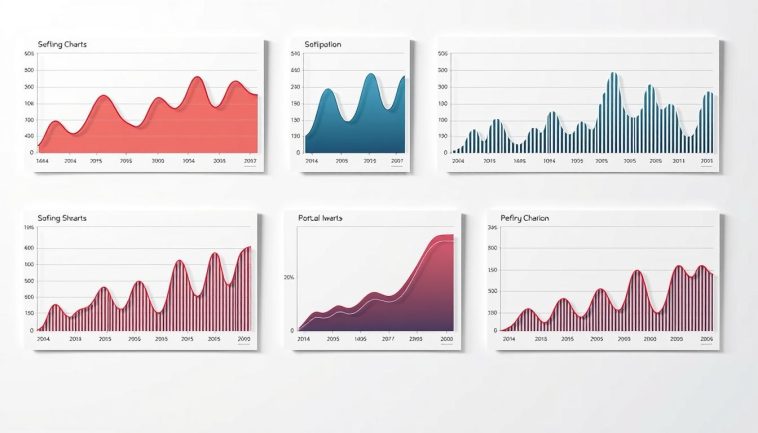
Strip charts are key in data visualization, helping professionals show data clearly. They plot individual data points on one axis. This makes it easy to spot trends and patterns in complex data.
In this article, we'll explore strip charts in depth. We'll look at their definition, history, and how they improve visual analytics. We'll also cover how to make them, their advantages, and uses in healthcare, business, and education.
Learning about strip charts can change how organizations understand data. It leads to smarter decisions and deeper insights.
Table of Contents
What are Strip Charts?
A strip.chart is a tool for showing data in a clear way. It plots numbers along a line. This makes it easy to compare different data sets. Knowing what strip charts are helps us see data better. They help spot trends, clusters, or odd points quickly. This makes understanding data easier.
Strip charts make complex data simple. They show patterns and changes in data clearly. This helps us make better decisions based on the data.
Strip charts started in the early 1900s, when statistics became important in fields like medicine and social sciences. Back then, they were made by hand, which was hard work.
Now, thanks to technology, making strip charts is much easier. They are now a key part of data visualization. Thanks to tools like Excel, more people can use them to understand data better.
Additionally, you can explore how tools like Nothing2Hide Net Salesforce contribute to efficient data management.
Importance of Data Visualization
Data visualization is key to clear communication, showing its data visualization importance across many areas. It turns complex data into easy-to-understand visuals. This makes it simple for people to see trends and connections.
Charts and graphs help make data easy to read. This makes it useful for many people. It shows how powerful visual data interpretation can be.
- The Role of Visuals in Data Interpretation: Visuals are big helpers in visual data interpretation. They make hard data look simple. The strip charts effect is clear in this, making data easy to get. These visuals help us see patterns fast. They are key in places where quick decisions are needed.
- Enhancing Decision-Making Processes: Data visualization is vital in making decisions. Tools like strip charts help us understand data better. This makes decision-making faster and more accurate. In business or healthcare, visuals reduce confusion. They let us focus on important insights. This way, we can make better choices based on clear data, not just numbers.
How to Create a Strip Chart

Creating a strip chart makes data easier to understand. There are many tools and software for making these charts. They help show data in a clear and attractive way.
Tools and Software for Strip Chart Creation
There are many tools for creating strip charts. Microsoft Excel and Google Sheets are good for basic charts. Tools like Tableau and R offer more features for complex data.
Each tool has an easy-to-use interface. This makes it simple to pick your data and create a chart that fits your needs.
Step-by-Step Guide to Building a Strip Chart
To make a great strip chart, just follow these steps:
- Collect the data you want to analyze and pick a dataset.
- Choose a tool or software for creating strip charts.
- Use the software's chart function to pick the strip chart option.
- Put your data into the chart.
- Make the chart better by changing legends, labels, and colors.
- Check the chart for mistakes and fix them if needed.
By following this guide, you can make a strip chart that clearly shows your data. This helps you understand your information better.
Benefits of Using Strip Charts
Strip charts are great for showing data in a simple way. They are easy to understand, making them perfect for sharing information with many people. This is especially true for those who don't know a lot about technical stuff.
- Simplicity and Clarity: Strip charts are known for being simple. They make data easy to see and understand. This is really helpful in work settings, where you need to share complex ideas clearly.
- Comparison with Other Chart Types: Strip charts are better than some other types of charts. They are cleaner and focus on the important details. This makes it easier for people to see and understand the data.
- Real-World Applications: Strip charts are used in many areas. In healthcare, they help with quick diagnoses. In business, they show important trends. And in schools, they help with research presentations. These examples show how useful strip charts are for sharing data.
Strip Chart Applications in Various Fields
Strip charts are used in many areas, helping with data understanding and decision-making. They are key in healthcare, business, and research. Their ability to show data clearly makes them very useful.
- Healthcare and Urine Test Strips Results Chart: In healthcare, strip charts are crucial for tracking urine test results. They help doctors see test results quickly, which is important for diagnosing diseases like diabetes. This clear display of data helps doctors make fast treatment plans.
- Business Analytics and Marketing: Businesses use strip charts to show data in analytics and marketing. They make it easy to see sales, customer feelings, and market trends. This helps teams make better plans based on the data they see.
- Education and Academic Research: In schools, strip charts are important for analyzing research data. Researchers use them to show study findings, track interactions, and review test scores. Strip charts make it easy to share complex data with everyone.
Tips for Effective Strip Chart Design

Creating effective strip chart data needs careful thought on design elements. Choosing the right dataset and a good visual style are key. This ensures the chart clearly conveys the message.
Choosing the Right Data to Display
Choosing the right data is crucial for impactful strip charts. Focus on datasets that show important trends or patterns for your audience. Here are some tips:
- Identify key metrics that match your visualization goals.
- Make sure the data is relevant and shows the story you want to tell.
- Check how important the data is in the context of the chart.
Color and Style Considerations
Color and style choices are vital in data visualization. They can make or break understanding. To improve clarity:
- Use contrasting colors to make data points stand out.
- Keep a consistent style for clear visual communication.
- Don't forget labels and legends, as they help users interact with the chart.
Common Challenges with Strip Charts
Strip charts are great for showing data, but they have some big challenges. These include data misinterpretation and making visualizations too complicated.
- Misinterpretation of Data: One big problem with strip charts is that people might get the data wrong. If the chart is hard to understand or the scale is unclear, viewers might make mistakes. It's important to have clear labels and titles. Good labeling and titles help people get the data right. They make it easier to understand what the chart is showing.
- Overcomplicating the Visualization: Another issue is making strip charts too complicated. Too many data points or extra notes can take away from the main point. It's key to keep things simple. By simplifying the chart, we make sure it focuses on the important stuff. This way, viewers don't get lost in too much information.
Conclusion
Strip charts are a key tool in data visualization. They are simple and clear. They make data easy to understand. Using these charts well can bring big benefits. It helps in getting clearer insights and better analysis.
When made right, strip charts show trends and oddities. They can reveal things that are hard to see otherwise. Overcoming common problems and following best practices is key. This way, anyone can use strip charts to their fullest. They are a big part of showing complex data in a simple way.
For more insights on effective data visualization techniques, visit Fem2pt0.
FAQs
Q: What are the benefits of using strip charts in data visualization?
A: Strip charts are simple and clear. They make complex data easy to understand. This is great for sharing findings with people who aren't experts.
They also help spot patterns that might be missed in other charts.
Q: How do strip charts compare to other chart types?
A: Strip charts are cleaner and easier to read than bar or line charts. They show each data point clearly. This gives more info without being too much.
This makes it easier to understand the data.
Q: What tools are recommended for creating strip charts?
A: Tools like Microsoft Excel, Google Sheets, Tableau, and R are good for making strip charts. They have easy-to-use interfaces. This lets users focus on their data for better visuals.
Q: In which fields are strip charts most commonly used?
A: Strip charts are used in many areas. In healthcare, they help analyze urine test results. In business, they show market data. In education, they aid in research.
They're useful in many fields because they're adaptable.
Q: What are some common challenges when using strip charts?
A: Challenges include misreading data due to unclear scales or labels. Also, too much data or unnecessary notes can confuse. Good design and simplicity help avoid these problems.
This ensures the main points are clear.
Q: What is the significance of color and style in strip chart design?
A: Color and style choices are key to understanding data. Using contrasting colors makes data points stand out. Consistent design helps viewers get the message.
Good labels and legends also help avoid confusion.
Q: How can strip charts aid in decision-making processes?
A: Strip charts help make decisions by showing data in a clear way. This makes it easy to see trends and connections. It reduces confusion, leading to quicker and better decisions.
This is especially true in critical areas like business and healthcare.
Q: Can strip charts be useful for time series data?
A: Yes, strip charts work well for time series data. By plotting points along a time axis, they show trends and patterns over time. This makes it easy to spot changes and anomalies.



